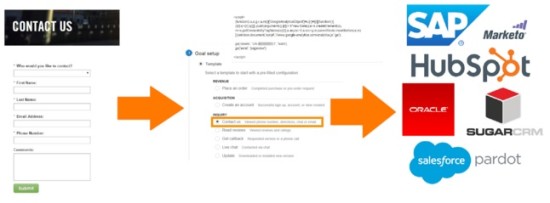This blog post will show you how to estimate how much each form submission is worth to your business. First, you’ll need a few things to do the calculation properly.
Define Goal Values in Google Analytics
Adding values to your goal conversions in Google Analytics (GA) is the first step in estimating the ROI of your marketing campaigns on a non-ecommerce website. While it may take a bit of work up-front to calculate your goal values properly, adding dollar amounts to your goals in GA will let you add three key factors to your web analytics reporting:
- Deeper ROI analysis for ads to non-ecommerce websites; specifically sites designed for contact form fills.
- Context of what is important and what isn’t for your site. Obviously, your KPI Framework should guide this, but goal conversion values are a good gut check for that.
- Communicate your work’s value to colleagues outside the marketing department. They may not understand (or even care!) what bounce-rate, attribution, or goal conversions are on their own, but once they see how these relate directly to the money their business is making, they’ll be sure to listen up.
Pre-requisites
Once your goal values are defined in GA, you’ll need to ensure you also have the following:
- A contact form on your website
- A Google Analytics goal setup tracking those form submissions
- Google Analytics tracking code on every page on your site
- A Customer Relationship Management (CRM) and/or Marketing Automation (MA) system where you can extract (1) contact form submission volume, (2) closed deals which started via contact form submissions (or a very good estimation of it) and (3) total revenue from contact form initiated sales.
That last point is key. The data available is unique to your organization and whichever CRM/MA system you use, so don’t worry if you can’t get everything right off the bat. You can always setup your workflow now to calculate this in the near future.

If you don’t currently tag leads with their generation channel (Form, Linkedin Message, phone call, and etc.) in your CRM/MA system, then this gives you a good excuse to start!
How to Calculate Goal Value
- Gather your form submission and revenue data into a central place like an Excel or Google spreadsheet. Make sure you’re comparing your form submission volume and revenues resulting from form submissions in the same time period. This is essential, otherwise, you might end up with a wildly inaccurate estimation.
- Figure out your form’s sales-conversion rate – what percentage of the folks who submit your form go on to become a customer or client? The formula looks like this:
- (Closed Deals from Form Submissions / Total form submissions) = Conversion Rate
- Multiply your new-found conversion rate by the average revenue generated by leads coming from your form(s). Your formula is:
- Conversion Rate * (Total Form Lead Revenue / # Form Submissions)
Let’s try an example:
Adam’s wedding photography website contact form received 100 submissions last month. 10 of those turned into sales, making him $10,000.
His form has a 0.1 conversion rate (10/100). That means each form submission is worth (0.1 * ($10,000 Total Revenue /10 Sales ).
(10 Sales / 100 Submissions) * ($10,000 Total / 10 Sales) = $100 a form submission.
Now Adam can accurately calculate which of his paid marketing campaigns (AdWords, Bing Ads, Facebook ads, and etc.) leading to his website landing pages are worth running!
Other Use Cases
Contact form fills aren’t the only thing you can add dollar value to. Form-gated whitepaper or ebook downloads, newsletter signups, webinar registrations, and free/trial accounts are all fair game. It’s typically more difficult to associate these actions with revenue though, since unlike contact form submissions they don’t directly lead to a conversation with your sales team.
Things to Remember
- Use recent data in your calculations – you want to accurately reflect your business where it is now, not 2 years ago. If your business model, website, product/service offering, or anything else changed radically at some point, only include data from after things became established. Ideally you want the largest possible date range for your data set, so small blips and anomalies over time will be minimized.
- Update goal values often to reflect your changing business and customer base
- Your customers may trigger multiple goals on your site, especially if they end up converting, so remember that this method is an approximation rather than an exact calculation.
What Next?
Excellent! You’ve done what was impossible a few years ago – estimated the real business value of your website contact forms. Now it’s time to unleash your new superpowers. Do a gut check: is your contact form worth more than you expected? Or, are you wasting money driving traffic to a form that doesn’t actually help you?
If you’re looking for more information on how to navigate the interface, Google’s Analytics Help Center is the place to start. Also, check out their resources on Google Analytics Goals and Importing Cost Data.

















